The On Grid PV Inverter Market is estimated to be valued at USD 32.2 billion in 2025 and is projected to reach USD 76.9 billion by 2035, registering a compound annual growth rate (CAGR) of 9.1% over the forecast period. Between 2025 and 2030, the market is expected to rise from USD 32.2 billion to USD 49.7 billion, driven by the increasing adoption of solar energy systems and the expansion of solar power installations worldwide. Year-on-year analysis shows consistent growth, with values reaching USD 35.1 billion in 2026 and USD 38.3 billion in 2027, supported by advancements in inverter technologies and the declining cost of solar power generation. By 2028, the market is forecasted to reach USD 41.8 billion, advancing to USD 45.6 billion in 2029 and USD 49.7 billion by 2030.
Growth is expected to be fueled by the rising demand for efficient, reliable, and high-performance inverters in residential, commercial, and industrial solar installations, as well as innovations in smart grid integration, storage solutions, and inverter scalability. These dynamics position the on-grid PV inverter market as a critical component in the global push toward renewable energy, offering substantial opportunities for growth and innovation.
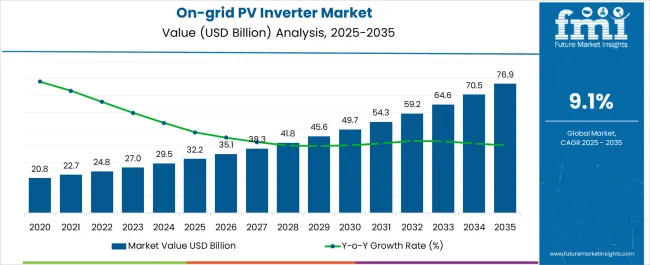
| Metric | Value |
|---|---|
| On Grid PV Inverter Market Estimated Value in (2025 E) | USD 32.2 billion |
| On Grid PV Inverter Market Forecast Value in (2035 F) | USD 76.9 billion |
| Forecast CAGR (2025 to 2035) | 9.1% |
The on grid PV inverter market is experiencing strong growth driven by increasing investments in renewable energy infrastructure, declining solar installation costs, and supportive government policies aimed at grid decarbonization. Widespread adoption of solar photovoltaic systems across residential, commercial, and utility sectors has elevated demand for efficient grid connected inverter solutions.
Advances in inverter design, including enhanced MPPT algorithms and real time grid interaction capabilities, are further supporting operational efficiency and grid stability. Growing emphasis on energy self sufficiency and integration of distributed energy resources has accelerated the uptake of intelligent inverter technologies.
The outlook remains robust as energy transition goals and carbon neutrality targets continue to expand across global markets, pushing for scalable, cost effective, and high performance on grid inverter solutions.
The on-grid PV inverter market is segmented by product, phase, nominal output power, nominal output voltage, application, and geographic regions. By product, the on-grid PV inverter market is divided into String, Micro, and Central. In terms of phase, the on-grid PV inverter market is classified into single-phase and three-phase. Based on nominal output power, the on-grid PV inverter market is segmented into ≤ 0.5 kW, 0.5 - 3 kW, 3 - 33 kW, 33 - 110 kW, and > 110 kW. By nominal output voltage, the on-grid PV inverter market is segmented into ≤ 230 V, 230 - 400 V, 400 - 600 V, and > 600 V. By application, the on-grid PV inverter market is segmented into Residential, Commercial & industrial, and Utility. Regionally, the on-grid PV inverter industry is classified into North America, Latin America, Western Europe, Eastern Europe, Balkan & Baltic Countries, Russia & Belarus, Central Asia, East Asia, South Asia & Pacific, and the Middle East & Africa.
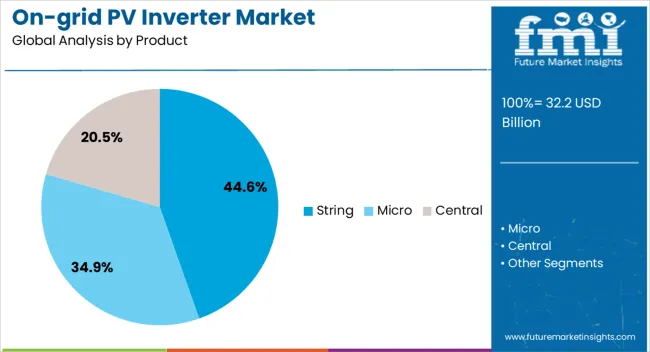
The string inverter product segment is expected to account for 44.60% of the total market revenue by 2025, positioning it as the leading product type. This dominance is attributed to its modular architecture, ease of installation, and lower maintenance requirements.
String inverters are highly favored for residential and small commercial solar applications due to their cost efficiency and reliable performance. Their compatibility with rooftop systems and ability to manage partial shading make them ideal for distributed installations.
Additionally, continuous improvements in monitoring capabilities and efficiency have further increased their market appeal. These factors collectively support the strong market position of string inverters in grid-connected PV systems.
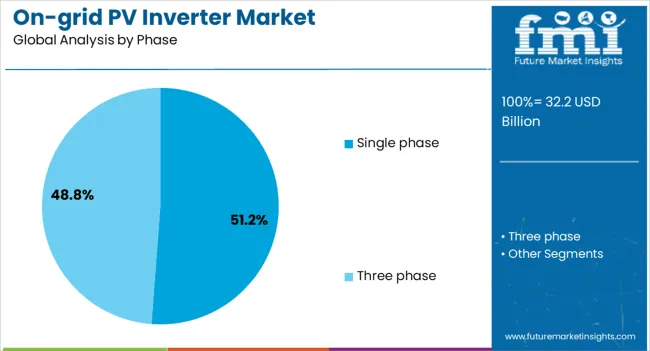
The single phase category is projected to contribute 51.20% of total market revenue by 2025 within the phase segment. This growth is primarily driven by rising residential solar adoption, particularly in suburban and urban areas where single phase grid connections are common.
Single-phase inverters are compact, easy to install, and well-suited for low to medium-capacity systems. Their cost-effectiveness and seamless integration with existing home electrical systems have made them the preferred choice for homeowners and small businesses.
As distributed generation gains traction and residential solar systems become more mainstream, demand for single-phase on-grid inverters continues to grow, reinforcing their leadership in this segment.
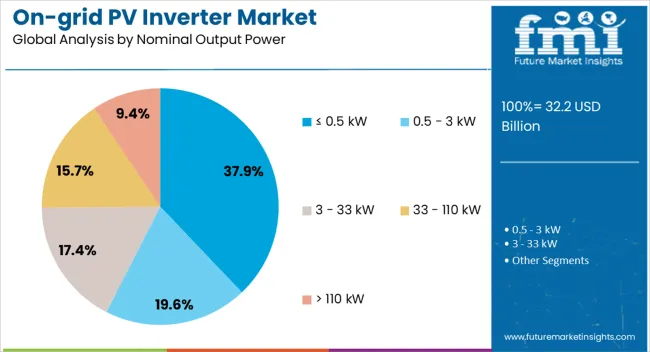
The segment with nominal output power less than or equal to 0.5 kW is expected to capture 37.90% of the total market by 2025. This share is supported by the increasing deployment of compact solar systems in residential and off-site locations.
These inverters are particularly suited for small rooftop installations, modular systems, and emerging microgeneration setups. Their affordability, lightweight design, and ease of integration into low-voltage networks contribute to their adoption in cost-sensitive markets.
As energy access initiatives and urban solar programs continue to expand, the demand for low-capacity grid-connected inverters is set to rise, making this output power range a vital contributor to the overall market.
The market is driven by the increasing demand for renewable energy and presents opportunities in cost reduction and energy storage integration. Emerging trends such as smart grid technology and energy management solutions are reshaping the market. However, challenges such as grid infrastructure limitations and regulatory barriers must be addressed for continued growth. By 2025, addressing these challenges through improved infrastructure and regulatory support will be crucial for unlocking the full potential of on-grid solar power systems and ensuring sustained market expansion.
The growing demand for renewable energy sources drives the On-Grid PV Inverter market. As governments and industries aim to reduce reliance on fossil fuels and meet emission targets, the adoption of photovoltaic (PV) systems for residential, commercial, and industrial applications is rapidly increasing. On-grid inverters, which enable the integration of solar power into the grid, are crucial in maximizing energy efficiency and ensuring a reliable power supply. By 2025, the market is expected to continue expanding, driven by the global shift toward clean energy sources.
The market presents opportunities in cost reduction and energy storage integration. As the cost of solar panels and inverters continues to decline, the financial feasibility of adopting on-grid PV systems improves for both homeowners and businesses. Additionally, integrating energy storage solutions, such as batteries, with on-grid PV systems offers further value by allowing surplus energy to be stored and used later, thereby improving grid reliability. By 2025, the continued cost reduction and energy storage integration will be significant drivers of growth in the On-Grid PV Inverter market.
Emerging trends in the On-Grid PV Inverter market include the increasing integration of smart grid and energy management solutions. Smart grids, which enable more efficient electricity distribution and monitoring, are becoming essential as the adoption of renewable energy increases. On-grid inverters equipped with smart technology enable real-time monitoring and optimization of energy usage, improving system efficiency and reducing waste. By 2025, these innovations will enhance the overall performance of on-grid PV systems, making them more attractive for residential and commercial applications.
Despite growth, challenges such as grid infrastructure limitations and regulatory barriers persist in the On-Grid PV Inverter market. In many regions, existing power grids lack the capacity to efficiently integrate large-scale solar energy production, resulting in energy losses and inefficiencies. Additionally, regulatory frameworks and policies governing solar energy generation and grid integration may limit market growth, especially in emerging markets where regulations are still evolving. By 2025, overcoming these barriers will be key to unlocking the full potential of the on-grid PV inverter market.
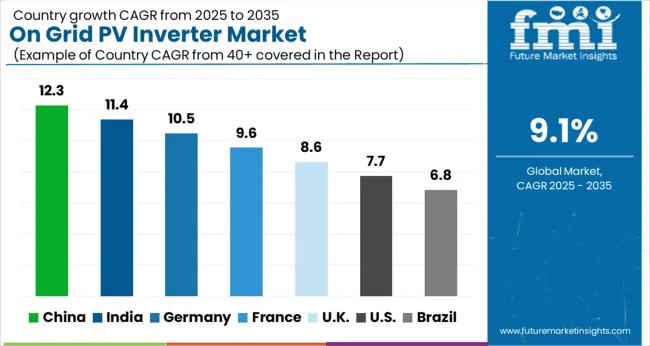
| Country | CAGR |
|---|---|
| China | 12.3% |
| India | 11.4% |
| Germany | 10.5% |
| France | 9.6% |
| UK | 8.6% |
| USA | 7.7% |
| Brazil | 6.8% |
The global on-grid PV inverter market is projected to grow at a 9.1% CAGR from 2025 to 2035. China leads with a growth rate of 12.3%, followed by India at 11.4%, and Germany at 10.5%. The United Kingdom records a growth rate of 8.6%, while the United States shows the slowest growth at 7.7%. These varying growth rates are driven by the increasing demand for solar energy solutions, government incentives for renewable energy adoption, and technological advancements in photovoltaic systems.
Emerging markets like China and India are experiencing higher growth due to rapid infrastructure development, industrial expansion, and government policies supporting solar power, while more mature markets like the USA and the UK see steady growth driven by regulatory frameworks, technological innovation, and the growing push towards sustainability and clean energy adoption. This report includes insights on 40+ countries; the top markets are shown here for reference.
The on-grid PV inverter market in China is growing rapidly, with a projected CAGR of 12.3%. China’s massive investments in renewable energy, particularly solar power, continue to drive the demand for on-grid PV inverters. The country’s ambitious goals to increase its renewable energy capacity, coupled with government policies supporting clean energy technologies, are key drivers of market growth. China’s focus on energy efficiency and sustainability, along with its increasing adoption of solar power for industrial and residential applications, further accelerates the market adoption of on-grid PV inverters. Additionally, China’s strong manufacturing base for solar inverters and components continues to support the growing market for on-grid PV inverters.
The on-grid PV inverter market in India is projected to grow at a CAGR of 11.4%. India’s rapidly expanding solar energy sector, combined with government initiatives promoting clean energy, is driving strong demand for on-grid PV inverters. The country’s growing focus on sustainable energy solutions, particularly in rural and urban electrification, is contributing to the rising adoption of solar energy systems. Additionally, India’s large-scale solar projects and increasing investments in infrastructure for solar energy generation, storage, and distribution further contribute to market growth. The government’s incentives and tax rebates for solar power installations are also driving the demand for on-grid PV inverters.

The on-grid PV inverter market in Germany is projected to grow at a CAGR of 10.5%. Germany’s strong commitment to renewable energy, coupled with its focus on reducing carbon emissions, continues to drive steady demand for on-grid PV inverters. The country’s regulatory frameworks supporting the adoption of clean energy, along with its emphasis on expanding solar energy infrastructure, contributes to the growth of the market. Additionally, Germany’s strong industrial and residential demand for energy-efficient, decentralized power generation systems, along with the increasing focus on energy independence, further accelerates the adoption of on-grid PV inverters. Germany’s leadership in renewable energy technology further supports the growth of the on-grid PV inverter market.
The on-grid PV inverter market in the United Kingdom is projected to grow at a CAGR of 8.6%. The UK’s focus on transitioning to clean energy, particularly solar power, continues to drive steady market growth. The government’s strong policies and incentives for renewable energy generation and adoption of energy-efficient systems are contributing to the demand for on-grid PV inverters. Additionally, the increasing focus on sustainability, coupled with the UK’s commitment to reducing carbon emissions and meeting renewable energy targets, accelerates the adoption of solar power technologies. The growing demand for residential and commercial solar installations further supports the growth of the on-grid PV inverter market in the UK
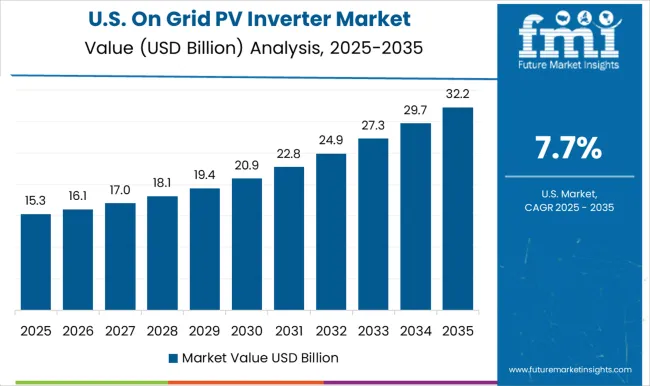
The on-grid PV inverter market in the United States is expected to grow at a CAGR of 7.7%. The USA market is driven by increasing demand for solar power solutions, government incentives for renewable energy adoption, and the growing focus on energy efficiency. The country’s efforts to reduce carbon emissions, increase the use of clean energy technologies, and modernize its power infrastructure contribute to the steady growth of the on-grid PV inverter market. Additionally, the rising number of residential and commercial solar installations, along with innovations in solar energy storage and management systems, further boosts the demand for on-grid PV inverters in the USA
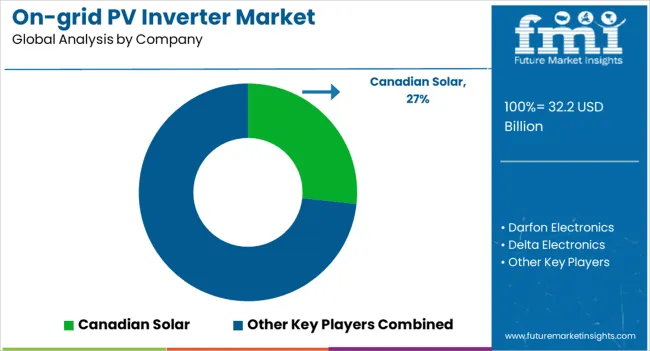
The on-grid PV inverter market is dominated by SolarEdge Technologies, which leads with its innovative solar inverters and power optimizers designed for residential, commercial, and industrial solar systems. SolarEdge’s dominance is supported by its cutting-edge technology, high efficiency, and strong focus on improving energy production and reliability in grid-connected solar power systems. Key players such as Enphase Energy, SMA Solar Technology, and Schneider Electric maintain significant market shares by offering advanced inverter solutions that integrate seamlessly with grid-connected solar systems, providing real-time monitoring, optimization, and performance analytics. These companies focus on delivering energy-efficient, scalable solutions that meet the increasing demand for renewable energy systems and grid stability.
Emerging players, including GoodWe, Fimer Group, and Delta Electronics, are expanding their market presence by offering specialized on-grid PV inverters for niche applications, such as microgrids, commercial buildings, and smart cities. Their strategies include improving product reliability, enhancing inverter performance under varying environmental conditions, and reducing system costs to cater to price-sensitive markets. Market growth is driven by the increasing adoption of solar energy, growing demand for clean, renewable power, and the global push for energy independence. Innovations in inverter design, hybrid solutions, and integration with energy storage systems are expected to continue shaping competitive dynamics and fuel further growth in the global on-grid PV inverter market.
| Item | Value |
|---|---|
| Quantitative Units | USD 32.2 Billion |
| Product | String, Micro, and Central |
| Phase | Single phase and Three phase |
| Nominal Output Power | ≤ 0.5 kW, 0.5 - 3 kW, 3 - 33 kW, 33 - 110 kW, and > 110 kW |
| Nominal Output Voltage | ≤ 230 V, 230 - 400 V, 400 - 600 V, and > 600 V |
| Application | Residential, Commercial & industrial, and Utility |
| Regions Covered | North America, Europe, Asia-Pacific, Latin America, Middle East & Africa |
| Country Covered | United States, Canada, Germany, France, United Kingdom, China, Japan, India, Brazil, South Africa |
| Key Companies Profiled | Canadian Solar, Darfon Electronics, Delta Electronics, Eaton, Enphase Energy, Fimer Group, GoodWe, Schneider Electric, Servotech Power Systems, SMA Solar Technology, Sungrow Power Supply, Solis Inverters, SolarEdge Technologies, Statcon Energiaa, UTL Solar, and V-Guard Industries |
| Additional Attributes | Dollar sales by inverter type and application, demand dynamics across residential, commercial, and utility-scale sectors, regional trends in on-grid PV inverter adoption, innovation in energy efficiency and smart grid integration, impact of regulatory standards on energy production and environmental concerns, and emerging use cases in solar power storage and grid optimization. |
The global on grid PV inverter market is estimated to be valued at USD 32.2 billion in 2025.
The market size for the on grid PV inverter market is projected to reach USD 76.9 billion by 2035.
The on grid PV inverter market is expected to grow at a 9.1% CAGR between 2025 and 2035.
The key product types in on grid PV inverter market are string, micro and central.
In terms of phase, single phase segment to command 51.2% share in the on grid PV inverter market in 2025.






Our Research Products

The "Full Research Suite" delivers actionable market intel, deep dives on markets or technologies, so clients act faster, cut risk, and unlock growth.

The Leaderboard benchmarks and ranks top vendors, classifying them as Established Leaders, Leading Challengers, or Disruptors & Challengers.

Locates where complements amplify value and substitutes erode it, forecasting net impact by horizon

We deliver granular, decision-grade intel: market sizing, 5-year forecasts, pricing, adoption, usage, revenue, and operational KPIs—plus competitor tracking, regulation, and value chains—across 60 countries broadly.

Spot the shifts before they hit your P&L. We track inflection points, adoption curves, pricing moves, and ecosystem plays to show where demand is heading, why it is changing, and what to do next across high-growth markets and disruptive tech

Real-time reads of user behavior. We track shifting priorities, perceptions of today’s and next-gen services, and provider experience, then pace how fast tech moves from trial to adoption, blending buyer, consumer, and channel inputs with social signals (#WhySwitch, #UX).

Partner with our analyst team to build a custom report designed around your business priorities. From analysing market trends to assessing competitors or crafting bespoke datasets, we tailor insights to your needs.
Supplier Intelligence
Discovery & Profiling
Capacity & Footprint
Performance & Risk
Compliance & Governance
Commercial Readiness
Who Supplies Whom
Scorecards & Shortlists
Playbooks & Docs
Category Intelligence
Definition & Scope
Demand & Use Cases
Cost Drivers
Market Structure
Supply Chain Map
Trade & Policy
Operating Norms
Deliverables
Buyer Intelligence
Account Basics
Spend & Scope
Procurement Model
Vendor Requirements
Terms & Policies
Entry Strategy
Pain Points & Triggers
Outputs
Pricing Analysis
Benchmarks
Trends
Should-Cost
Indexation
Landed Cost
Commercial Terms
Deliverables
Brand Analysis
Positioning & Value Prop
Share & Presence
Customer Evidence
Go-to-Market
Digital & Reputation
Compliance & Trust
KPIs & Gaps
Outputs
Full Research Suite comprises of:
Market outlook & trends analysis
Interviews & case studies
Strategic recommendations
Vendor profiles & capabilities analysis
5-year forecasts
8 regions and 60+ country-level data splits
Market segment data splits
12 months of continuous data updates
DELIVERED AS:
PDF EXCEL ONLINE
On-grid Three Phase PV Inverter Market Size and Share Forecast Outlook 2025 to 2035
Utility On Grid PV Inverter Market Size and Share Forecast Outlook 2025 to 2035
On Grid Solar PV Market Size and Share Forecast Outlook 2025 to 2035
On Grid Residential Micro Inverter Market Size and Share Forecast Outlook 2025 to 2035
Standalone PV Inverter Market Size and Share Forecast Outlook 2025 to 2035
Standalone Three Phase PV Inverter Market Size and Share Forecast Outlook 2025 to 2035
PV Inverter Market Analysis by Product, Phase, Connectivity, Nominal Power Output, Nominal Output Voltage, Application, and Region through 2035
PVC Container Market
Non PVC Plasticizers Market Growth & Outlook 2022 to 2032
Grid Connected Microgrid Market Size and Share Forecast Outlook 2025 to 2035
PV Micro Inverters Market Trends & Forecast 2025 to 2035
DC Grid Connected Microgrid Market Size and Share Forecast Outlook 2025 to 2035
AC Grid Connected Microgrid Market Size and Share Forecast Outlook 2025 to 2035
Traction Inverter Market
Grid Scale Stationary Battery Storage Market Size and Share Forecast Outlook 2025 to 2035
PVC Electrical Conduit Market Size and Share Forecast Outlook 2025 to 2035
String PV Inverter Market Size and Share Forecast Outlook 2025 to 2035
EV Traction Inverter Market Size and Share Forecast Outlook 2025 to 2035
Construction Portable Inverter Generator Market Size and Share Forecast Outlook 2025 to 2035
Single Phase PV Inverter Market Size and Share Forecast Outlook 2025 to 2035

Thank you!
You will receive an email from our Business Development Manager. Please be sure to check your SPAM/JUNK folder too.
Chat With
MaRIA